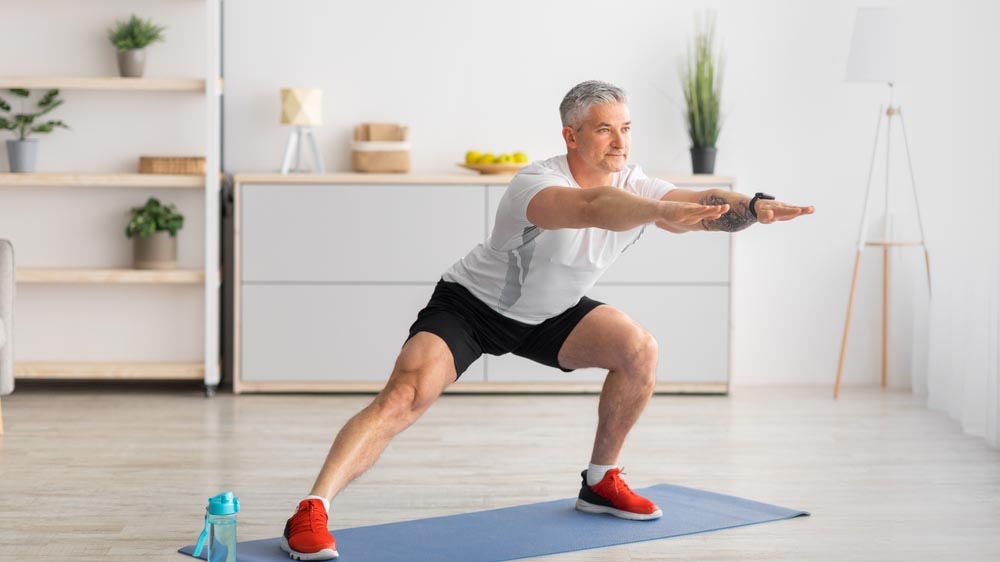
If lateral lunges don’t have a place in your leg day routine, you’re missing out. This exercise can strengthen many of the major muscle groups in your lower body including your quads, hamstrings, inner and outer thighs, and glutes.
My squat form had been suffering lately, and I knew a change in my leg workouts was needed. As a personal trainer, I’m well aware of how beneficial lateral lunges are, but admittedly, I’ve been skipping them to save some time.
So I decided to roll out my yoga mat and focus more attention on lateral lunges, even if it meant I’d be a little behind schedule.
How to do the lateral lunge
You don’t need any equipment to do a lateral lunge, but you might want a yoga mat for support. You may also choose to use dumbbells or kettlebells to increase the exercise’s difficulty.
- Stand tall with your feet together and toes pointing in front of you.
- Pick your left foot up and take a wide step to the left, keeping your toes pointed straight ahead.
- With most of your body weight on your left foot, set your hips back as if you were about to sit into a chair.
- Bend your left knee, keeping your left heel on the floor and your left knee aligned over the middle of your left foot.
- Keep your right leg straight and your right foot planted on the floor.
- Once you’ve reached the end of your range, stand tall and step your left foot back to the starting position.
- Continue for 10-12 repetitions, then repeat the exercise on the right side.
When performing the lateral lunge, be sure to keep your torso upright and spine in a neutral position – don’t allow your chest to fall forward or your back to round. Here’s what happened after committing to a week’s worth of lateral lunges.
My squat form improved
Recently, I had started to notice some knee valgus (a condition where the knees collapse inward) during my heavy squats. This is usually an indication that the hip abductor muscles and glutes need strengthening – areas that the lateral lunge targets.
After including lateral lunges in my leg days more consistently, my knee valgus diminished and my squat attempts felt strong and solid. I was even able to add a little more weight without sacrificing good form.
Despite being a basic functional exercise, squats can be somewhat challenging to master. If you’ve been having trouble with any part of your squat, adding lateral lunges to the mix could be the solution.
My knees felt more stable
Years of running and high-impact exercise paired with less-than-optimal mobility practices have taken their toll on my joints. As a result, my knees can feel a bit shaky when lifting heavy or trying out new movements.
While this minor instability was present during my first few days of lateral lunges, it started to decrease as the week progressed. By the end of the week my knees felt more stable than they had in a long time, and that stability transferred to all of my regular lower body work.
This was especially true for exercises like Bulgarian split squats and curtsey lunges – an often-wobbly right knee was steady the entire time. A lot of factors can affect stability, but unilateral (or one-sided) movements like lateral lunges can be useful in the pursuit of strong and healthy joints.
I increased weight on other lower body exercises
I’ve been trying to increase weight on my reverse lunges for weeks, but every time I think I’m ready, I’m humbled.
After focusing more attention on lateral lunges, I could finally do a full set of 10 reverse lunges holding a 40 pound dumbbell in each hand. Even if my squat form and knee stability hadn’t improved, this achievement alone would have been enough to convince me that lateral lunges needed a permanent place in my routine.
Sometimes fitness plateaus can be broken by switching up your training regimen. Consider adding lateral lunges to your leg days, especially if you haven’t been seeing much improvement in your strength levels.
My runs felt easier
Like many who pound the pavement in the best running shoes, I have a love-hate relationship with running. On the days where the miles tick by and I don’t even notice them, I love it. More often than not however, I’m huffing and puffing while watching every hundredth of a mile register on my Apple Watch.
I usually hop on the treadmill twice a week for a 5K, and at least one of those efforts will typically feel particularly hard. But after my lateral lunge experiment, my runs felt smooth, easy, and fun. That extended into the following week’s runs too. Whether this was directly related to the lateral lunges is hard to say, but they certainly didn’t hamper any of my running attempts.
A strong lower body is paramount for any runner, whether you’re training for a mile or a marathon. Lateral lunges strengthen nearly all of the muscles in your hips and legs, and that can lead to efficient and seemingly effortless runs.







